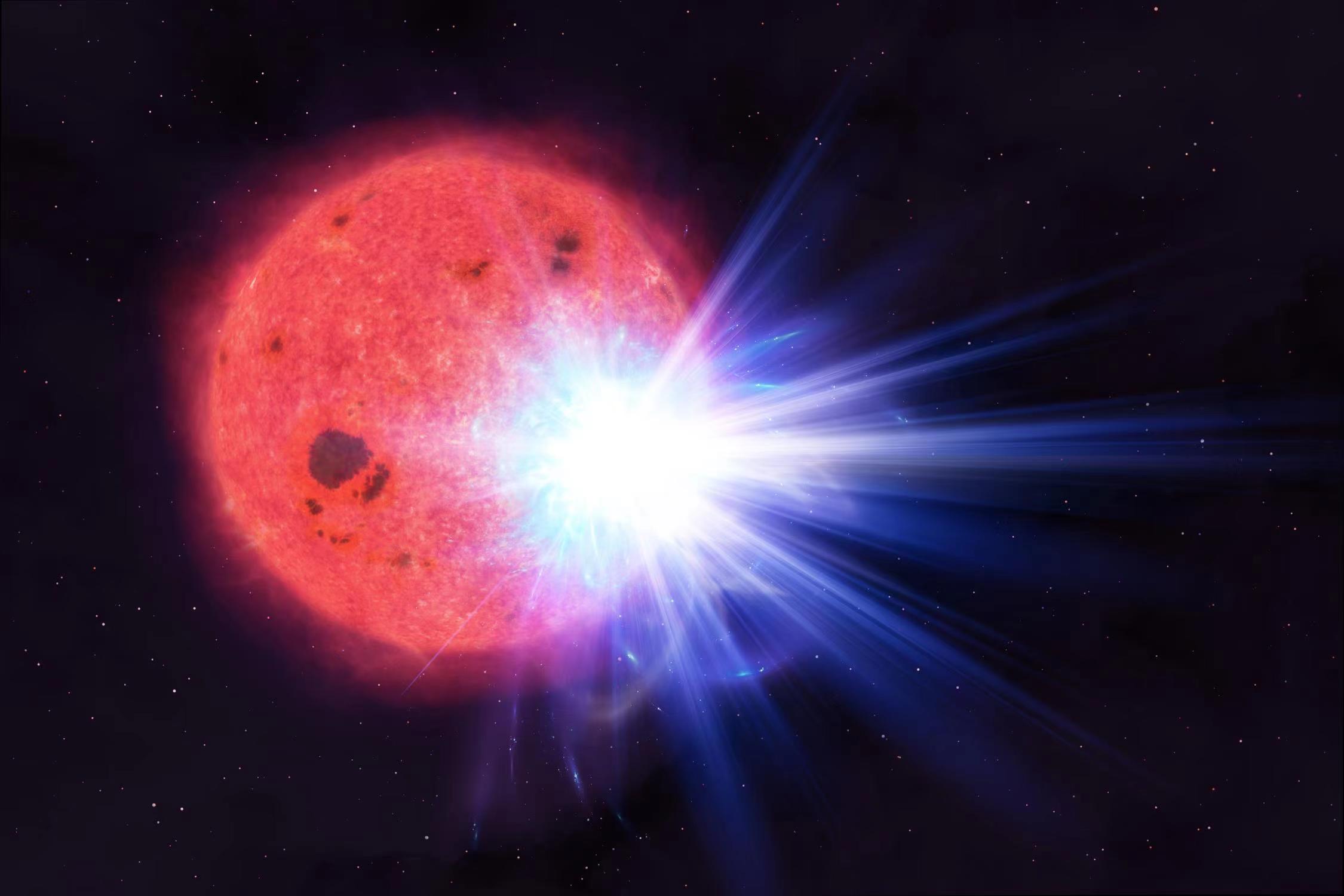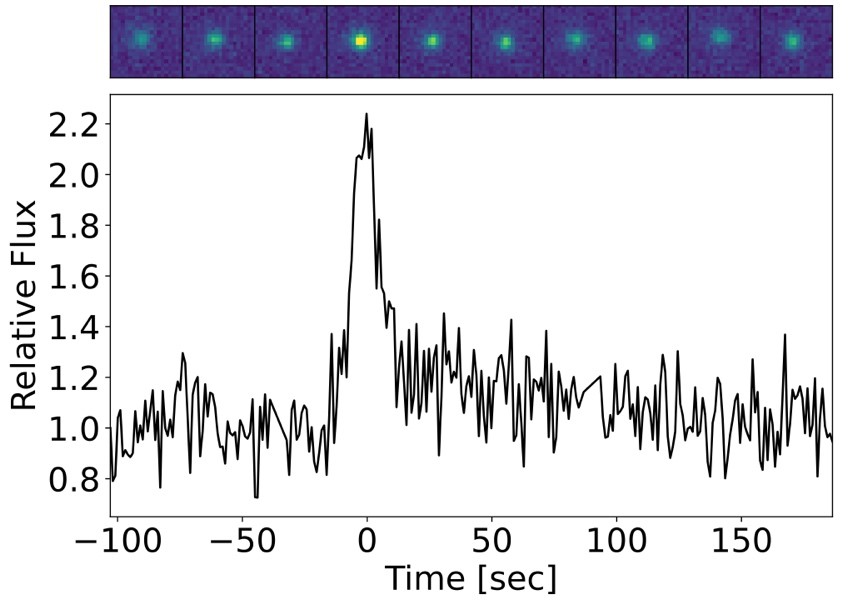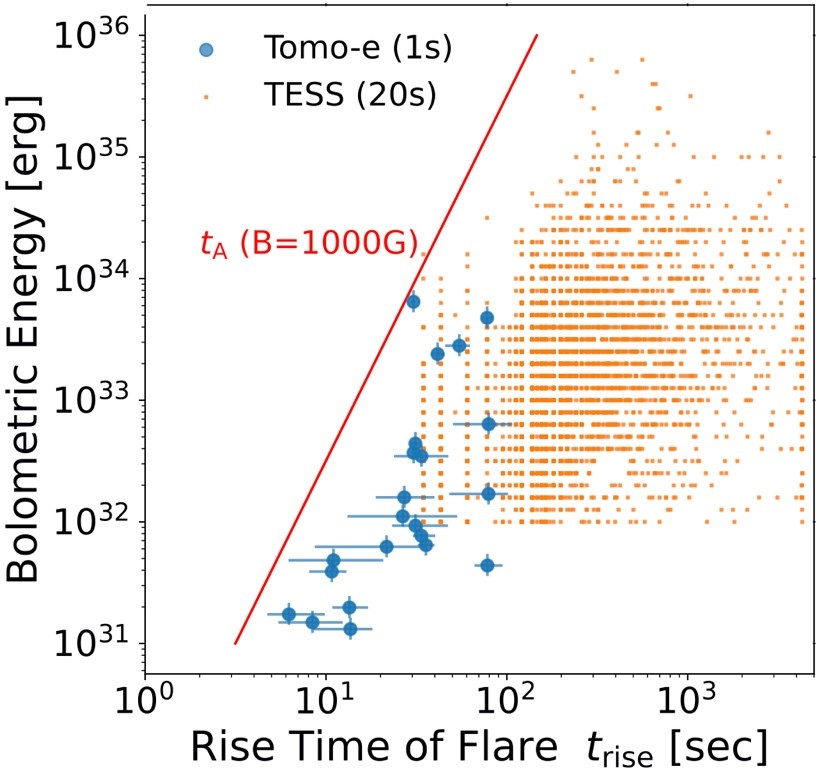Stellar flares are instantaneous explosions triggered by magnetic reconnection in the corona. They can be associated with high-energy particles and photons that can erode planetary atmospheres, and could have an impact on planetary habitability. A research group, led by TDLI postdoc fellow Dr. Masataka Aizawa, has identified a new population of very fast and powerful optical flashes from red dwarfs (Fig. 1) using Tomo-e Gozen, is an optical wide-field high-cadence observational system, allowing a "video" observation of the sky. The detected very fast and powerful flares are likely to be produced by strong magnetic fields, potentially affecting planetary habitability.

Fig. 1. Artistic illustration of very fast flares from red dwarfs (Image credit: Kiso Observatory, the University of Tokyo).
Red dwarfs are the smallest and coolest stars among main-sequence stars. They tend to be magnetically active so that they are good targets for studying stellar flares. In 2021, astronomers spotted a very fast flaring event from a red dwarf, Proxima Centauri, which is the closet star to our Sun and harbors a potentially habitable planet. At the flaring phase, the brightness increased by a factor of >1,000 in the radio band and >14,000 in the ultraviolet band. On the other hand, an optical emission was difficult to be resolved by the TESS satellite, which also monitored Proxima Centauri at the moment, and the origins and optical counterparts of such fast flares have been unclear.
Tomo-e Gozen is the optical camera mounted on the 1.05m Kiso Schmidt telescope maintained by the University of Tokyo. It can monitor 20.7 square degrees at 1-2 frame-per-seconds, allowing a "video" survey of the sky. With its unique capability, it can simultaneously observe a few hundreds of red dwarfs, enabling us to explore very fast flares efficiently. Using Tomo-e Gozen, the research team has searched for stellar flares from more than 5,700 red dwarfs. As a result, they successfully identified 22 very fast and energetic flares, which have been difficult to be detected by any other telescope (Fig. 2).

Fig. 2. Example of flaring lightcurve. Upper panels show series of integrated images over 10 seconds with an interval of 28 seconds.
The detected flares have rising timescales ranging from six to several tens of seconds, and the stellar brightness increased by up to 20 times. Such very fast and powerful flares can be explained by the energy release from strong magnetic fields, which are likely to be associated with high-energy particles. They indeed represent the bright end of fast optical flares ever found (Fig. 3). The research group also investigated stellar properties of flaring stars using the LAMOST (The Large Sky Area Multi-Object Fibre Spectroscopic Telescope) archival data, and found that 10 out of 11 targets are magnetically active stars. This suggests that very fast and powerful flares are much more likely to occur at active stars. The average event rate of fast flares on active stars is estimated to be roughly once a day, implying that such events happen frequently. 
Fig. 3. Flare energy and rising time for flares detected by Tomo-e Gozen (blue) and TESS (orange). Red line is a theoretical prediction, which corresponds to the Alfvén transit timescale with B=1,000G.
With its high-cadence observations, Tomo-e Gozen has successfully resolved flaring lightcurves (Fig. 4). The research group argued that the rise and decaying patterns can be explained by the chromospheric compression model for flares, in which the rise times are described by Alfven transit timescale while the decaying part is explained by the radiative cooling of the compressed chromosphere, possibly down to near the stellar photospheres.

Fig. 4. Collection of flaring lightcurves discovered in this study. Black and red lines correspond to data and flare models.
In this study, the research team has discovered very fast and power flares from red dwarfs. They are likely to be triggered by magnetic reconnection with strong magnetic fields, and could have an impact on planetary habitability around red dwarfs. The research team will continue to explore very fast flares from different types of stars using Tomo-e Gozen, and will reveal stellar activities and their effects on planetary habitability further.
Publication: Masataka Aizawa, Kojiro Kawana, Kazumi Kashiyama et al., “Fast optical flares from M dwarfs detected by a one-second-cadence survey with Tomo-e Gozen", PASJ 2022, https://academic.oup.com/pasj/advance-article/doi/10.1093/pasj/psac056/6656381?searchresult=1
Contacts
Masataka Aizawa
Postdoctoral Fellow
Tsung-Dao Lee Institute, Shanghai Jiao Tong University
Email: aizw_ms@sjtu.edu.cn

